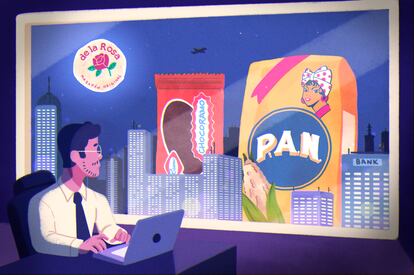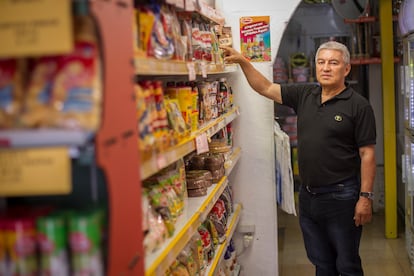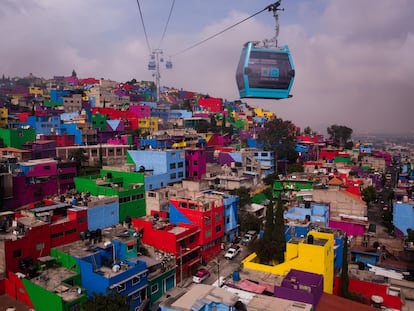The nostalgia economy
What began with treats lugged back and forth in suitcases from trips home has evolved into an industry driven by the taste of the soft drinks, candy, pastries and cheesy bites of childhood. Latino expatriates will do anything to get their fix. We delve into a transnational food industry driven by homesickness

Melanie Pérez Arias was nearly brought to tears — by a sandwich. “Yesterday was a very special moment for us as migrants,” the Venezuelan journalist tweeted in mid-August. “After four years we got hold of some mortadella very similar to Venezuelan mortadella,” she wrote, referring to the lunchmeat sausage she loves. Pérez Arias’s husband is Peruvian, and they decided to move to Peru together after Venezuela became a country where tracking down bread was difficult. “Peruvians don’t know how to live without bread,” said Pérez Arias. Back in Lima, bread was in plentiful supply, but the mortadella they ate in Caracas was missing. It took the couple four years to combine the basic components of the snack they longed for. “We almost cried,” half-joked Pérez Arias. The relentless search to stave off the longing for the tastes of home — that’s what drives the nostalgia economy.
As Latin Americans have fanned out across the globe, so have these tastes from home
Anyone uprooted by the circumstances of life can understand the outsize emotion an encounter with a bit of sausage from home might bring. One might think of the Peruvian grandmothers who were stopped at Lima airport in the 1980s and 1990s for trying to pass a kilo of the country’s distinctive yellow potatoes to their exiled children in Long Island or Santiago. They understood perfectly the unique character of an ingredient, a flavor linked to memory. As Latin Americans have fanned out across the globe, so have these tastes from home. We might consider the joy of the first Mexican who was able to buy a bottle of Salsa Valentina (spicy sauce) in Shanghai, the Guatemalan family who sits down to eat Pollo Campero in Las Vegas, the Argentines who filled their suitcases with alfajores (a cookie sandwich) before the product’s Havanna brand appeared in the duty free shops, or the Colombians who search Madrid top to bottom for Supercoco candies.
Those with a sharp eye for consumer tastes also spotted this market niche, and have followed the trail of the Latin American diaspora and its gastronomic longings in order to grow their brands or set up new businesses. A man’s true homeland is not childhood, as Rilke said: it is the flavors of childhood. And if that flavor costs three times as much when you are abroad, no one regrets paying for it. The six stories that follow are all a lesson in cashing in on nostalgia, and the pleasures of our earliest tastes.
El ‘mazapán’ mexicano
With more than 11 million Mexican-born people living in the United States, the candies and snacks of home are a booming market. Mexican corner stores and online shops cater to shoppers searching for sweet and salty tamarind (Pulparindo), chips with Mexican flavorings (Rancheritos or the Ruffles in a green bag), spicy condiments (Valentina or Tajín), or hazelnut Duvalín sweets. These can now also be found in special aisles of supermarkets in Mexico’s northern neighbor.
But there is one sweet snack that rises above the rest: Mexican marzipan, or “mazapán”. Made with peanuts rather than the almond of the European version, mazapán is typically Mexican, with a powdery texture that melts in the mouth. It’s the typical simple treat that tastes like home.

“With mazapán and Duvalín, for example, it doesn’t bother me to pay a dollar for one because not only do they taste so good, they also remind me of Mexican culture, of the corner store, of being a kid eating those sweets,” said Roberto Yáñez, a 38-year-old Mexican living in Vancouver, Canada. Yáñez pays up to three times what he would in Mexico, but that’s not the point. “They remind me of my childhood, my dad, all of that.”
Dulces de la Rosa, a company from Jalisco in Mexico, claims the original mazapán recipe as its own, but in different parts of the country they are sold under other brand names. Dulces de la Rosa produces 10 million mazapán daily, and a few years ago announced plans to open a new plant in Costa Rica to supply the Central American market. In addition to the United States, the company also exports to Canada, Europe and the Middle East, according to its website. Grupo Bimbo, the world’s largest bakery, is the owner of favorites such as Duvalín, and also thrives on Mexicans’ nostalgia abroad.
Argentine empanadas
When Mariano Najles arrived in Barcelona in 2005, his Argentine stomach cried out for the empanadas, or filled pastries, he was used to eating in his home province of Tucumán. A few Argentine restaurants in the city copied recipes from Buenos Aires, but tasted different – and not in a good way. Eight years ago, he and another Tucumán native, Daniel Rojas, decided to make the empanadas themselves, and founded the store Las Muns. They sold the meat empanadas like the ones they longed for, but also offered flavors adapted to local tastes. It was a roaring success. Today, with 21 locations in Madrid, Barcelona and other cities, they sell around two million empanadas a year, Najles said over the phone.
“Meat empanadas are a matter of national pride, but from the beginning we also offered caprese, which is very Mediterranean; chicken curry; and tuna, which is more like the Galician empanada,” he said. In Spain, an empanada is more of a sheet of filling topped with a layer of pastry, rather than the filled crescents of the Argentine version. In recent years they have branched out even further, with a vegan cheeseburger version, or a cheesecake empanada scattered with rose petals.

Nostalgic Argentines come in search of the classics; others are more open to try new things. “When an uncle of mine came to visit, we offered him a tasting session ranging from the lightest to the heaviest, which is the Tucumán empanada. He was eating and looking at us, without saying anything. He started with the caramelized onion and walnuts, then the caprese, then another one and then he finally ate the Tucumán empanada and said: ‘At last the pastries are finished’,” Najles laughed. “There must be a wanted poster of us back home, because making colored empanadas is some form of sacrilege”, he joked, pointing to the black pastry of the tuna version made with squid ink.
Claudia Briandi arrived in Madrid in 2001, in the middle of Argentina’s economic depression, and is still there two decades later. In the early years, she recalled, it was almost impossible to find classic Argentine products, such as dulce de leche or yerba mate [a herbal tea], and she would plead every acquaintance who traveled from Buenos Aires to Madrid to bring her some. Today they are sold in supermarkets.
The same thing happened with empanadas. Five years ago, when she saw how stores selling this typical Argentine product were proliferating in Barcelona, she decided to open Malvón with two Spanish partners. Today they have more than 40 branches and make more than 400,000 empanadas a week. “The empanadas are made by hand and that is one of the problems because you need a lot of specialized staff,” she explained, describing the traditional way of sealing the dough, which in Argentina varies according to each filling and allows the customer to know at a glance what is inside. A few months ago, Briandi took a step back from Malvón to focus on a new venture in “milanesas,” an Italian dish of breaded steak that has been remixed in Argentina.
Brazilian pão de queijo (cheese bread)
Pão de queijo is one of Brazil’s most popular snacks, made of tapioca flour and cheese. No one knows exactly where they came from, but it is said that the recipe was created in the 18th century in the state of Minas Gerais. Tapioca flour was substituted for hard-to-find wheat flour to make the dough, they say, and the cheese came from the dairy tradition of the region. It is now an essential part of Brazilian gastronomy and has long conquered hearts across the country and beyond. Wherever there are Brazilians across the world, you will find pão de queijo. This is also due to its versatility, as you can eat it for breakfast, as an afternoon snack, or in the evening, and it is gluten-free.

After 11 years living in Italy, Patricia Sadala, born in Minas Gerais, does her best to make it herself. When relatives visit, the only condition she usually imposes on them is to put the ingredients for cooking pão de queijo in their suitcases. When no one comes to visit, Patricia, who lives on the outskirts of Turin, frequents a supermarket a few kilometers away where they sell the mix to make it. She also visits a minimart where different products typical of Latin America are sold. “I can find many Brazilian products there, even frozen pão de queijo,” she enthused.
Forno de Minas Alimentos, the market leader in the sale of frozen cheese bread in Brazil, has exported to other countries for many years now. Currently its pão de queijo is shipped to the United States, Colombia, Uruguay, Chile, Paraguay, Peru, Guatemala, El Salvador, Panama, Costa Rica, Canada, Portugal, the United Kingdom, China, United Arab Emirates and Japan. In the United States, where there is a huge Brazilian community, the company has been present for two decades and even has a branch in Miami. “Brazilians cannot live without their cheese bread. And foreigners are also good customers,” said Hélder Mendonça, CEO of Forno de Minas.
Venezuelan arepa
There are probably more arepa outlets outside Venezuela than in the country itself. With an ever-growing diaspora, the country’s filled cornmeal bun may become the new Chinese food — delicious and ubiquitous. In 2018, an initiative called ‘Locos por las arepas’ (Crazy for arepas) attempted to map places selling arepas and counted 520 businesses in 51 countries. Wherever Venezuelans have gone – elsewhere in Latin America, Asia or South Africa – they have taken arepas with them. This globalization was driven in part by P.A.N. flour, which began production in 1960 in Turmero, in Venezuela’s Aragua state. Venezuelan corn flour is now a fairly accessible product, wherever you happen to be. In the 1970s, it was exported to the Canary Islands, where arepas are consumed as a local delicacy. Today it is sold in the largest supermarket chain in the United States, Walmart, and more than 90 countries. Empresas Polar, one of the oldest companies in Venezuela, produces the P.A.N. flour brand, and expanded first to a plant in Colombia, which produces 140,000 tons per year. Factories in the United States followed; then to Europe in Italy and Spain. The latter site opened in Madrid last year in the middle of the pandemic. Its corn base has given it greater momentum in recent years, as gluten-free products have become more fashionable and a better understanding of celiac disease has led to an explosion of products catering to sufferers.

P.A.N. stands for National Food Product in Spanish. Since 1992, and by presidential decree, Venezuelan corn flour has been fortified with vitamins and iron. The demand for corn flour and its state backing entailed a leap in the industrialization of corn processing, which until the middle of the 20th century was ground by women. The P.A.N. flour produced today in Venezuela is made with imported corn. The area seeded with this staple cereal has contracted brutally with the economic crisis, and has gone from millions of hectares to hundreds of thousands, which barely covers 20% of the local demand.
This corn flour is not only used for sweet or savory arepas. It is also the base for hallacas, or Venezuelan tamales, which are fried and turn a golden color because of the sugar added to the dough. The yellow packaging of P.A.N. Flour has become a pop culture icon with its cobs and logo inspired by the samba singer Carmen Miranda, and designed by Bulgarian Marko Markoff. The flour is also adapted to other cuisines for traditional tamales, or polenta. On the back of the bag is a recipe for arepas, one that surely only foreigners have read. It instructs you to divide the dough into 10 portions, form them into balls, flatten them with your hands into discs of 10 centimeters in diameter, then cook on a griddle for five minutes on each side. The number of steps belies how simple it is to make an arepa after mixing flour, water and salt. Among Venezuelans, the preparation is an unspoken rite that is learned in the family, has its own songs, and is carried off in a suitcase when emigrating.
Peruvian Inca Kola
Inca Kola is Peru’s preferred accompaniment for the Peruvian-Chinese food known as chifa, but it is also a classic fixture of birthdays and parties. It has the neon yellow color of a highlighter and its flavor is somewhere between lemongrass and chewing gum. The first units were sold in 1935, and since the 1960s it has become inextricably linked with Peruvian identity: “Drink Inca Kola, the national flavor!” was its slogan.

In 1999, Coca Cola Company bought 49% of the shares of Lindley, the Peruvian company that bottled Inca Kola, after realizing Coke sales were always a distant second to the national beverage. Millions of Peruvians migrated following the economic crisis of the 1980s and 1990s, and Inca Kola cans were among the most prized gifts when there was no international distribution network. These days it is also bottled in the United States and Chile, two of the countries with the largest number of Peruvian expatriates. A company created in 1999 by a Cuban in New Jersey distributes Inca Kola in 32 US states and in Japan, Australia, South Korea, Spain and Panama. The same Cuban had been selling bottles of Inca Kola from the back of a taxi since the 1980s in Miami.
Nico Vera, a Peruvian vegan chef based in Portland, Oregon, remembers the soda as his favorite drink as a child. “I would drink it to go with arroz chaufa [Peruvian fried rice] or with a sandwich for lunch, and I would drink it on hot summer afternoons,” he said. His parents migrated with the family to the Dominican Republic, and after a few years settled in Toronto.
“Living abroad in the 1970s and part of the 1980s, Peruvian products were still not available where we lived, and we missed Doña Pepa nougat, panettone, D’Onofrio ice cream and Inca Kola. But from time to time we would travel to Lima and bring back some products to enjoy on special occasions,” he recalls. The chef says that when Inca Kola was finally being shipped abroad, his family would buy “big bottles for lunch on July 28,” which is Peru’s national holiday
Vera has stopped drinking soda as an adult, but if he felt the urge for some national flavor he could now find it at one of Portland’s Latino markets. “What I realize now is that we always had other options, we could have chosen Coca Cola or something else, but we always chose Inca Kola: I think that like all other Peruvian food or drink it gave us some pride because it was part of our culture,” he added.
Colombian pound cake at CVS
Chocoramo, a rectangular chocolate-covered cake, is one of Colombia’s iconic baked goods. Since the 1950s it has been a staple in the lunchboxes of thousands of Colombian children, and one of the most missed by those who live far away. With its orange wrapper and toasted corners, and the Ramo brand written in cursive letters, it is unmistakably Colombian.

With its national treasure status, the news that it will now be sold in CVS pharmacies in the United States for $0.99 was greeted with quiet glee by Colombian migrants living there. “A Colombian can spot a Chocoramo from a kilometer away,” said Santiago Molano, grandson of Rafael Molano, one of the brand’s founders. To reach a wider audience, however, the company is thinking of naming it Chococake.
Chocoramo is the kind of product that can be found in any store or supermarket. Rafael Molano started selling cakes from a family recipe to friends at Bavaria, the brewery where he worked; then he sold them in stores, cut into individual portions and wrapped as if it were a bouquet, which was an idea from his wife, Ana Luis Camacho. It then became the cheapest birthday cake a Colombian could get, and over the years, they decided to coat it in chocolate. That’s how Chocoramo was born.
“We know that there are categories such as bakery and milling, confectionery, dairy and its derivatives, cocoa confectionery, alcoholic and non-alcoholic beverages, where the bulk of the country’s nostalgia exports are, which in most cases aim to reach not only Colombians abroad, but also Latinos and local consumers,” said Flavia Santoro, director of Procolombia.
Total exports of these sub sectors were equivalent to $422 million in 2020, or 5.4% of the agricultural products exported from Colombia during last year, according to Procolombia. She clarifies that not all goods in these categories belong to the so-called nostalgia products that are increasingly popular in European countries and the United States.
Other sweets such as Bon Bon Bum or Supercoco are frequently consumed in countries where Colombian migrants live in high numbers, such as Spain. Eduardo Ávila, born in Popayán, southwest Colombia, knows this well. He emigrated to Madrid 22 years ago and not only stayed but also created Intertrópico, a company dedicated to importing Latin American products to sell to migrants in Europe.

“Colombians want a lot of cane sugar, custard and sweet fritters for Christmas, and other products such as Jabón Rey, which they want to wash their hair and as a lucky charm, or because it reminds them of the country,” said Ávila from Madrid. Before he was an importer, he ran an international call shop, long predating WhatsApp and other internet-based communication services.
He bought some products of the kind that Latinos carried in their suitcases, and sold them in the call shop. With time and the arrival of more migrants, he saw a business opportunity and today he has a supermarket, and a distribution and marketing company for Latino products, which employs 20 people. He also imports frozen Latino soups, and even candles for the patron saints of each Latin American country.
He still can’t find everything that reminds him of home. Ávila is now trying to import borojó, a Colombian fruit, and manjar blanco, a dessert that particularly reminds him of home.
Credits
Coordination and editing: Lorena Arroyo and Eliezer Budasoff
Illustrations: Miki
Visual editing: Héctor Guerrero

